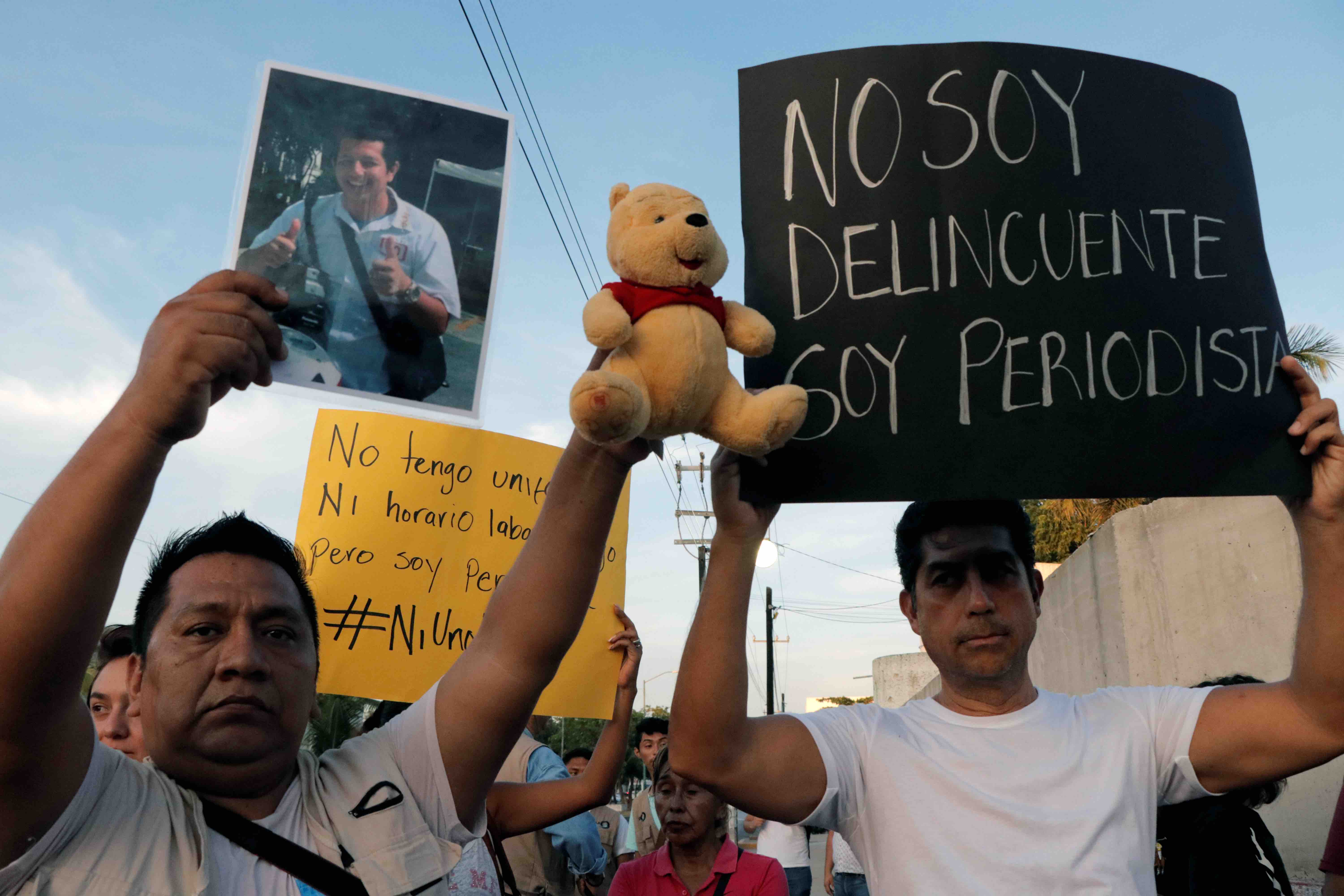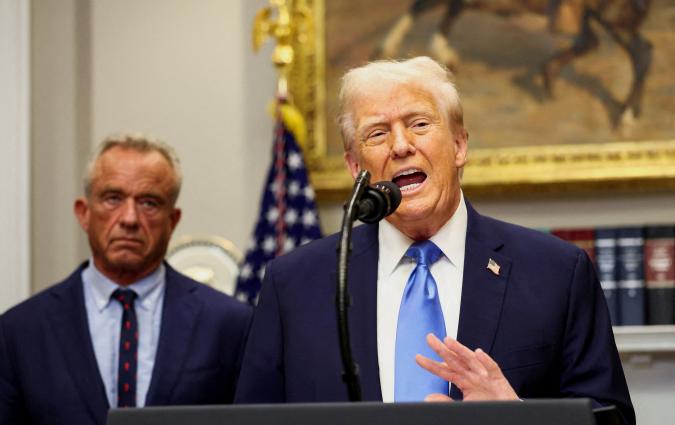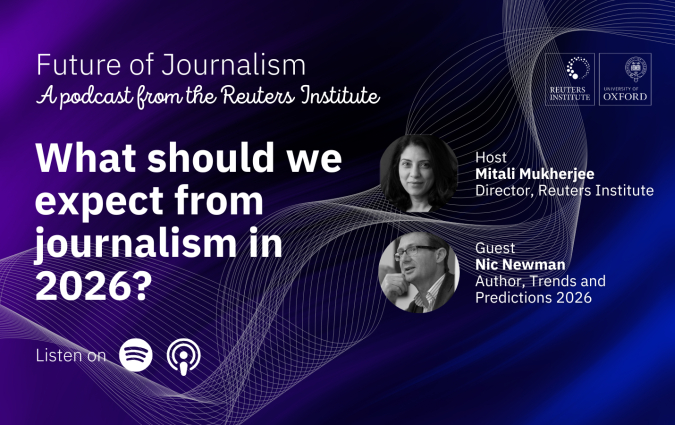I’ve studied journalists under pressure for 20 years. Here's what I've learned so far

A man hold a picture of cameraman Javier Rodriguez Valladares during a protest to demand justice for his killing in Cancun, Mexico in 2018. Banner reads "I'm not a criminal I'm a journalist". REUTERS/Israel Leal
Anthony Feinstein is a Professor of Psychiatry at the University of Toronto. He is the co-author of this report on the emotional toll on journalists covering the European refugee crisis that we published in 2017. This piece is a lightly edited transcript of his opening remarks at a seminar chaired by Meera Selva on 27 May 2020. You can watch the whole event in this link.
I’ve devoted 20 years to looking at the emotional well-being of journalists. I first became interested in the topic around 1999 when a patient was referred to my clinic with a very unusual presentation. She was a frontline journalist who had been working in East Africa. She had covered a lot of conflict, and over the years she’d become progressively distressed emotionally until she had this major breakdown, had to come back to Canada and was referred to my clinic.
She did really well in therapy. She made a full recovery, and I remember saying to her at the time, “Why had you not reached out for help earlier? You know, you work for a large news organisation – you knew that you were getting into trouble. Why did you not ask for assistance?”. And she said to me: “You don’t understand my profession. If I had told my manager I was feeling this way, they would not have sent me out into the field again and my career as a frontline correspondent would have been over.”
I was intrigued by her response. I thought this was somewhat punitive, and so I asked my research team at the time to go and look at the literature and tell me what had been published on the topic of journalists and trauma and emotional well-being. And they came back and said, “We can’t find a single paper”. I didn’t believe them because in medicine there’s always someone who’s been there before you. And so we went to the big library at the University of Toronto and we asked the librarians to check and they came back and said, “No, there’s nothing there.”
On the basis of that, I wrote a grant application and sent it to the Freedom Forum in Washington DC. Based on that early grant, we were able to undertake a study looking at frontline journalists who were working for the BBC, for CNN, for Reuters, Associated Press. I was given a Rolodex of 170 names of leading frontline journalists who basically defined their careers covering war and disaster and revolution. And we had a control group of journalists who had never done that, who’d stayed at home in Canada covering domestic news, and we had a look at topics like post-traumatic stress disorder (PTSD), depression, anxiety and substance abuse.
Watch the seminar here
How war reporters suffer post-traumatic stress disorder
What we found is that the group that went off to war had significantly more symptoms of PTSD, depression and anxiety. PTSD is a very significant mental illness and it can bring people down very hard [but] it’s very treatable. The first observation was that our response rate was over 80%, which is very unusual in the social sciences. This suggested that journalists actually wanted to talk about these kinds of experiences. We looked at the PTSD profile, depression, etcetera, and we showed that symptoms were much more marked in the frontline journalists.
We were able to show that their lifetime diagnosis, lifetime prevalence or diagnosis [is] very close to what you find in frontline veteran soldiers. This was a group that had spent on average 15 years in war zones. There is no other profession, I believe, that has such a lengthy exposure to war and trauma.
Soldiers had a tour of duty, maybe two, and they came home. But who spends 15 years or more in the world’s worst places? Journalists do, and in response to that, over the course of all the years, the rates of post-traumatic stress disorder were actually quite high.
So we did this study and we published it in the American Journal of Psychiatry, and news organisations took note of it because they were part of the study, and very slowly they started to change their practices. I think too slowly.
Are embedded reporters more protected?
Soon after we published this paper, the 2003 war in Iraq started. And my research group got a commission from two news organisations – CNN and ITN – to undertake a study looking at whether [militarily] embedded journalists are at greater risk for emotional difficulty or is it protective to be part of the military?
The effects showed early on that it made no difference. It didn’t matter whether you were with the military or not, because the journalists who were not with the military were so creative in getting to the frontlines.
We asked the journalists, within the first three months of the war in Iraq, to think back and tell us how many times they had been exposed to an event that could have killed them. And the average in the first three months was about three. Over the course of their career, that number is in excess of 20. This exposure to major stress and to events that could have killed them is part of what these journalists do.
Living (and reporting) in Mexico and Kenya
Then a third commission came our way. UNESCO said, “We are worried about journalists who live and work in dangerous places.”
Up until now my research was on western journalists who fly into bad places, stay four or six weeks and then come home. But the UNESCO question was a very different one, which was about journalists who live and work in dangerous places. And the example that they gave me was Mexico, because Mexican journalists covering the drug wars were leading very dangerous lives.
We did a study in Mexico looking at how Mexican journalists were coping emotionally with the challenges of covering the narco trafficking in the country, and it soon became apparent to me that this was even more dangerous work because there was no respite. The journalists would do their work during the day, but in the evenings they couldn’t really put their feet up and relax because they were still in the front lines of trouble.
What the drug barons had learned to do to get to a journalist was not just to target the journalist. They were targeting their families, their parents, their children, their grandparents. What we found in the Mexican sample was that one quarter of our sample surveyed had stopped working on a story because they were too traumatised to continue. What does that say about your society when you have a media group that is so scared that they really cannot continue with what they’re doing? I was amazed by the courage of these journalists. If they were personally threatened, they kept doing it. But when the narco people went after their children or their parents, one quarter of our sample stopped doing it.
What struck me about Mexico was that the message which had taken root in organisations like the BBC, Reuters and CNN that you’ve got to look after the emotional health of your journalists was simply not being followed in Mexico. There was no assistance, no help for these journalists. They were left to fend for themselves. In some organisations there was even a culture of silence, a very different way of dealing with this problem from what we see, for example, in Canada or the United Kingdom today.
As I started to present my journalism data and audiences listened very carefully to it, there was a recurring theme. Why had we not done this study in Africa? Why had we always focussed on western media? And so with a good colleague of mine, John Owen, we went to Kenya and we did a study there. And we looked at two events in Kenyan society. One was the violence around the elections, going back a decade, and the other one was the al-Shabaab attack on journalists at the Westgate Mall.
We showed that the journalists who were exposed to these traumas, particularly the election violence, had prominent symptoms of PTSD and depression many years after the event, because they hadn’t received treatment. This particular question was just not on the radar screen of news organisations in these countries.
The invisible scars of Iranian journalists
The final country that I just want to touch on is Iran. I did a study in Iran with my colleague Maziar Bahari, who is an Iranian Canadian journalist. Maziar had been incarcerated in Iran for three months after he went back to that country to visit his mother. So he had personal experience of how the regime treats journalists.
What we found again is that the regime is very harsh towards journalists who don’t toe the party line. They harass them, they lock them up, they beat them, and just as in Mexico they target their families as well. In fact, the level of trauma visited on Iranian journalists is extraordinary. In response to that, we found high rates of PTSD and depression once more. What was fascinating about the Iranian data was that those Iranian journalists who were traumatised had a tendency to self-medicate their distress. They were self-medicating with barbiturates. And barbiturates are a very, very old sedative and also very dangerous drugs. They are highly addictive. If taken in excessive quantities, they are fatal.
What you can see from the studies that I’ve outlined so far is that there’s a common theme. Expose people to trauma, hit them hard with violence, and you will find a percentage of individuals developing incapacitating emotional difficulties, be it PTSD, depression or anxiety. If there’s any good news in this story, it's this – news organisations are starting to change their tune. They’re becoming much more receptive to looking after journalists, to helping them with their emotional well-being.
Another key point is this – PTSD and depression and anxiety and substance abuse can be well treated. There are effective psychological therapies for these disorders, and so you don’t want to have these symptoms go untreated and suffer because of that. If someone has PTSD, it doesn’t just affect them. It affects their family, their children, their spouse. The knock-on effects of emotional trauma are considerable.
What I’ve learned over time is that this can also play havoc with the newsroom. If you’re a journalist in a far-flung place like Afghanistan, where there’s a small bureau, and one of your colleagues is traumatised and their behaviour becomes erratic and they’re irritable and their judgement is impaired, that’s not just bad for the journalist. It’s bad for the entire newsroom. And so it’s absolutely essential that news organisations pay proper attention to this question.
The pressing issue of moral injury
Before I conclude I just want to touch on something which is not a mental illness but which I think is very relevant, particularly under the pandemic restrictions right now, and that’s moral injury. Moral injury is not a mental illness. PTSD is. Depression is. Anxiety disorders are. All are mental illnesses. But moral injury is not, and moral injury is that injury done to one’s moral self by behaviour – either your behaviour or the behaviour of other people – that transgresses your moral code of ethics.
It’s what happens when you feel that somehow you’ve done something that might have compromised your own moral code of ethics, your own moral compass. But it can also come from witnessing other people’s behaviour as well. I’ll give you a classic example of moral injury in journalists. We all know the great war photographer Don McCullin [who] repeatedly speaks about the guilt that he feels at intruding into the lives of people who have endured great suffering. He says he’s built a career on the backs of other people’s suffering [and] that somehow through his behaviour, he’s compromised his own moral compass.
And moral injury is associated with two primary emotions – guilt and shame. I believe it’s prevalent amongst journalists who have to cover a very difficult story, and my experience of speaking to journalists who do this kind of work is that they’re being asked by the general public to step outside their role of journalist and to provide assistance to them in ways in which journalists are not trained to do. And if journalists refuse to do that, or they feel uncomfortable doing that, they have a sense somehow that they might have compromised themselves morally, and that’s a short road to moral injury.
I think this is something that we still have to come to grips with. I think it’s something that’s not discussed enough in journalism, but is certainly very prevalent. In many ways I think it’s going to be a lot more common than something like PTSD, just by the nature of the work you do. You’re on the front lines and you’re often called on to make very difficult choices that could put you at risk.
More on journalists under pressure:
- Read this report Professor Feinstein and Hannah Storm published on the emotional toll on journalists covering the European refugee crisis.
- Read this piece by Meera Selva on how COVID-19 is threatening press freedom worldwide.
- Donate to our Journalists Under Pressure Fund.







